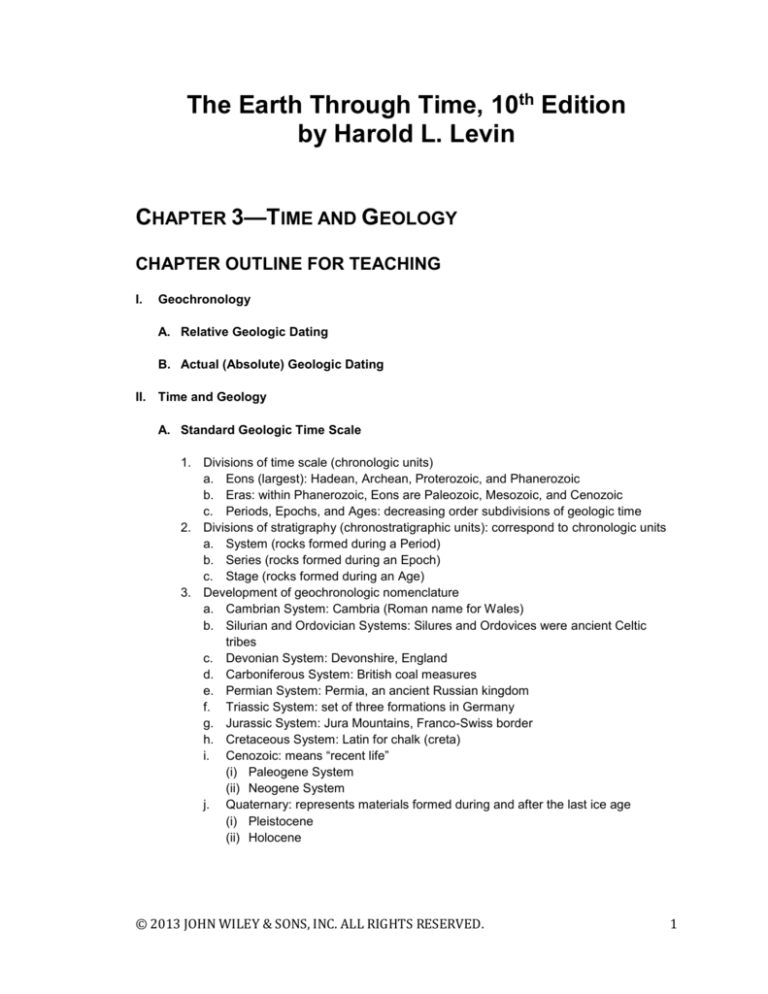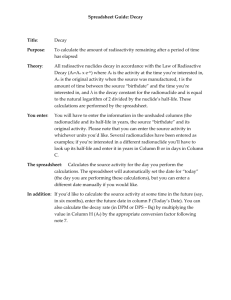
The Earth Through Time, 10th Edition
by Harold L. Levin
CHAPTER 3—TIME AND GEOLOGY
CHAPTER OUTLINE FOR TEACHING
I.
Geochronology
A. Relative Geologic Dating
B. Actual (Absolute) Geologic Dating
II. Time and Geology
A. Standard Geologic Time Scale
1. Divisions of time scale (chronologic units)
a. Eons (largest): Hadean, Archean, Proterozoic, and Phanerozoic
b. Eras: within Phanerozoic, Eons are Paleozoic, Mesozoic, and Cenozoic
c. Periods, Epochs, and Ages: decreasing order subdivisions of geologic time
2. Divisions of stratigraphy (chronostratigraphic units): correspond to chronologic units
a. System (rocks formed during a Period)
b. Series (rocks formed during an Epoch)
c. Stage (rocks formed during an Age)
3. Development of geochronologic nomenclature
a. Cambrian System: Cambria (Roman name for Wales)
b. Silurian and Ordovician Systems: Silures and Ordovices were ancient Celtic
tribes
c. Devonian System: Devonshire, England
d. Carboniferous System: British coal measures
e. Permian System: Permia, an ancient Russian kingdom
f. Triassic System: set of three formations in Germany
g. Jurassic System: Jura Mountains, Franco-Swiss border
h. Cretaceous System: Latin for chalk (creta)
i. Cenozoic: means “recent life”
(i) Paleogene System
(ii) Neogene System
j. Quaternary: represents materials formed during and after the last ice age
(i) Pleistocene
(ii) Holocene
© 2013 JOHN WILEY & SONS, INC. ALL RIGHTS RESERVED.
1
2
4. Geologists prominent in the early development of nomenclature
a. Adam Sedgwick (1785-1873): founder of the Cambrian System (1835);
co-founder with Murchison of the Devonian System (1839)
b. Roderick Impey Murchison (1785-1871): founder of the Silurian System (1835);
co-founder of the Devonian System (1839); founder of the Permian System
(1840)
c. Charles Lapworth: founder of the Ordovician System (1879; a compromise in the
feud between Sedgwick and Murchison due to overlap of the Cambrian and
Silurian Systems
d. Alexander von Humboldt (1769-1859): founder of the Jurassic System
B. Quantitative Geologic Time
1. Early estimates
a. Solar and lunar cycles versus events in the Old Testament: 6,000 years
b. Evolutionary rate calculation: beginning of Cenozoic was 80 million years ago
(Lyell, 1839)
c. Sediment deposition rate: computation age ranges from 1 million to 1 billion
years (done in the 1850s)
d. Salinity of sea water calculations: 90 million years since seas developed (Joly,
1899)
e. Rate of cooling calculation: 24 to 40 million years since formation (Kelvin, 1890s)
2. Modern radioactive-isotope methods and concepts
a. Radioactivity discovered in 1896 by Antoine Henri Becquerel (1852-1908);
investigated by the Curies who found more radioactive elements
b. Reviewing atoms: element; proton; neutron; electron; atomic number; atomic
mass; isotopes
c. Employs rate of natural, spontaneous breakdown of nuclear structure of atoms:
radioactivity
d. Parent nuclide = daughter product + particle expelled
e. Rate of nuclear decay is constant
f. Crystallization of minerals locks in an original quantity of radioactive atoms
g. Radioactive isotopes: each has a unique rate and mode of decay
h. Three types of radioactive decay: alpha, beta, and gamma (gamma radiation)
i. Radiometric dating of a crystal: possible because daughter products are retained
j. Original quantity of parent determined by counting daughter products (P + D = O)
k. Mass spectrometer: device used to measure minute amounts of isotopes
l. Half-life: span of time needed for one half of original atom to decay to daughter
product
m. Minerals in igneous rocks give the most reliable age dates
3. Principal geologic timekeepers: useful decay processes
a. Uranium-lead method: using Uranium235 or U238
b. Potassium-40/Argon-40 method: studies trapped Argon gas
c. 87Rb/86Sr method: uses straight-line (isochron) plots
d. Carbon-14 method: limitation is the half-life of 5,730 years
e. Nuclear fission-track counting in crystals
© 2013 JOHN WILEY & SONS, INC. ALL RIGHTS RESERVED.
Page 2
3
4. Age of the Earth
a. Oldest known Earth material is 4.36 billion years (zircon crystals from western
Australia)
b. Other very old rocks (over 4 billion years) come from Canada and Greenland
c. Age of meteorites: U/Pb and Rb/Sr dating yields 4.6 billion years
d. Moon rocks: U/Pb and Rb/Sr dates range from 3.3 to 4.6 billion years
Answers to Discussion Questions
1. Geochronologic units bear the same name as the chronostratigraphic units to which they
correspond, and are divisions of geologic time. Chronostratigraphic units are the full rock
record of corresponding geochronologic units, and are material features.
2. Earth’s formed about 4.6 billion years ago. Here are the ages of the beginning of the
following geochronologic intervals:
Proterozoic Eon
Paleozoic Era
Mesozoic Era
Cenozoic Era
Pleistocene Epoch
–
–
–
–
–
2.5 billion (2,500 million) years ago
542 million years ago
251 million years ago
65 million years ago
1.8 million years ago
3. The amount of parent isotope must be determined as well as the amount of daughter isotope
so that the parent:daughter ratio can be established. This ratio is important in determining
how much decay has occurred (e.g., how many half-lives have passed since the mineral
formed and locked in the radioactive element being studied).
4. The concept of half-life is necessary because it represents a convenient ratio (50:50) of
parent and daughter. Furthermore, half-life of most radiogenic elements studied is a
convenient duration (several 10s of millions of years) regarding geologic processes.
Carbon14 (half-life = 5,730 year) is an exception.
5. The pebble ages tell us that the sedimentary layer is younger than 300 million years.
6. Isotopes are atoms of the same chemical element that have variant mass numbers. All
isotopes of the same element have an equal number of protons, but the number of neutrons
varies, hence the mass variance.
7. Radioactive decay is a multi-step process with a predictable half-life. It behaves as a
timekeeper (or hourglass) so long as the System is not "disturbed." Any fracturing, repeating,
or metamorphic process can "reset" the atomic clock.
8. In the potassium-argon (K-Ar) method, if Ar is lost, the Age will be erroneous and will be
apparently younger than it really is.
9. C14 decays according to its half-life of 5,730 years. Having 12.5% of original C14 indicates
passage of 3 half-lives or 17,190 years.
© 2013 JOHN WILEY & SONS, INC. ALL RIGHTS RESERVED.
Page 3
4
10. If there is ¼ parent and ¾ daughter isotopes, then two half lives have passed. Therefore, the
age is 2,400 million years (or 2.4 billion years).
11. b
12. c
13. e
14. c
15. b
CHAPTER ACTIVITIES
Student activities for in-depth learning:
1. Make a geological time scale where one inch is equal to 100 million years. Plot this on a long
piece of paper. Make the geological time scale wide enough so that you can write the names of
the Eons, Eras, and Periods comfortably in the space you provide. Use the scale of one inch to
100 million years consistently throughout the diagram you are making. When finished, what do
you notice about the distribution of lengths of time within the Eons, Eras, and Periods? Speculate
on why this is. Take a look at a web page on chronostratigraphy (such as stratigraphy.org). Also,
look at web pages on the distribution of fossils through geological time.
2. Using web pages research the steps in the process of radiometric decay from parent Uranium238 to Lead-206 (e.g., http://www.health.ny.gov/environmental/radiological/radon/chain.htm). List
all the steps in the decay process, indicate whether alpha, beta, or other decay was involved in
each step, give the time required for each step to take place (on average), and list the parent and
daughter products in each step. You should find a dozen or more steps in this decay process.
© 2013 JOHN WILEY & SONS, INC. ALL RIGHTS RESERVED.
Page 4








